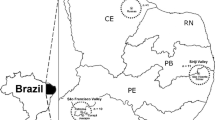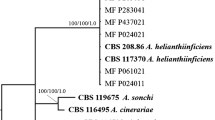Abstract
Sunflower (Helianthus annuus) stem canker caused by Diaporthe helianthi is one of the most important sunflower diseases in Croatia. Until recently, sunflower was the only known host for D. helianthi. In our research carried out in the area of Eastern Croatia, isolates of Diaporthe/Phomospis were collected from Xanthium italicum, X. strumarium and Arctium lappa. Using morphological, cultural and molecular ITS rDNA data, isolates from these weeds were identified as D. helianthi. The following isolates were used in the pathogenicity test: one isolate originated from sunflower (Su5/04), three from X. italicum (Xa2, Xa3 and Xa5), two from X. strumarium (Xa9 and Xa12), one from Xanthium sp. (Xa13) and one from A. lappa (Ar3). According to the results, it was determined that isolate Xa5 (originated from X. italicum) was the most pathogenic to sunflower stems. The average length of the lesion was 11.3 cm. The lowest level of pathogenicity was found in Xa9 (isolated from X. strumarium). The length of the lesion was 0.1 cm.

Similar content being viewed by others
References
Uecker FA. A world list of Phomopsis names with notes on nomenclature, morphology and biology. Mycol Mem. 1988;13:1–323.
Rehner SA, Uecker FA. Nuclear ribosomal internal transcribed spacer phylogeny and host diversity in the coelomycete Phomopsis. Can J Bot. 1994;72:1666–74.
Farr FD, Castlebury AL, Pardo-Schultheiss AR. Phomopsis amygdali causes peach shoot blight of cultivated peach trees in the southeastern United States. Mycologia. 1999;91:1008–15.
Murali TS, Suryanarayanan TS, Geeta R. Endophytic Phomopsis species: host range and implications for diversity estimates. Can J Microbiol. 2006;52:673–80.
Van Rensburg JCJ, Lamprecht SC, Groenewald JZ, Castlebury LA, Crous PW. Characterisation of Phomopsis spp. associated with die-back of rooibos (Aspalathus linearis) in South Africa. Stud Mycol. 2006;55:65–74.
Mihaljcevic M, Petrov M, Muntanola-Cvetkovic M. Phomopsis sp., a new sunflower parasite in Yugoslavia. Savremena Poljoprivreda. 1980;28:531–9.
Muntanola-Cvetkovic M, Mihaljcevic M, Petrov M. On the identity of the causative agent of a serious Phomopsis—Diaporthe disease in sunflower plants. Nova Hedwigia. 1981;34:417–35.
Homecken M, Franca Neto JB. Phomopsis sp. a new pathogen of sunflower. In: Resultados de Pesquisa de Girassol, Empresa Brasileira de Pesquisa Agropecuaria, Londrina (BR) 1982. p. 665.
Herr LJ, Lipps PE, Watters BL. Diaporthe stem canker of sunflower. Plant Dis. 1983;67:911–3.
Vőrős J, Leranth J, Vajna I. Overwintering of Diaporthe helianthi a new destructive pathogen of sunflower in Hungary. Acta Phytopathol Acad Sci Hung. 1983;18:303–5.
Iliescu H, Jinga V, Ciurea A, Ionita A. Investigations related to the prognosis of sunflower stem canker (Diaporthe helianthi). Helia. 1985;8:51–6.
Regnault Y. Preliminary observations on Phomopsis of sunflower. Bull CETIOM. 1985;92:13–20.
Zazzerini A, Tosi L, Losavio N. Rilievi fitopatologici su varietà di girasole a confronto nel 1987. L’Informatore Agrario. 1988;13:85–8.
Madjidich-Ghassemi. A new sunflower disease in Iran caused by Phomopsis helianthi. Proceedings of the 12th International Sunflower Conference, Novi Sad, Yugoslavia 1988. p. 108–9.
Rauf-Butta A, Rehbar MH, Sayed Irfan A, Iftikhar A. Prevalence and incidence of sunflower diseases in Pakistan. Helia. 1993;16:93–8.
Degener J, Melchinger AE, Hahn V. Interspecific hybrids as source of resistance to Sclerotinia and Phomopsis in sunflower breeding. Helia. 1999;22:49–60.
Demazure B. Phomopsis: Du progres dans les varietés. Grande Cult Infos. 1995;41:39–41.
Franco DA, Morales O. Influence of sunflower stem canker (Diaporthe helianthi) on seed quality and yield during seed development. Helia. 1997;20:57–62.
Laville J. Cahier technique tournesol: maladie. Paris: CETIOM; 1986.
Says-Lesage V, Roeckel-Drevet P, Viguié A, Tourvielle J, Nicolas P, Tourvieille de Labrouhe D. Molecular variability within Diaporthe/Phomopsis helianthi from France. Phytopathology. 2002;92:308–13.
Pecchia S, Mercatelli E, Vannacci G. Intraspecific diversity within Diaporthe helianthi: evidence from rDNA intergenic spacer (IGS) sequence analysis. Mycopathologia. 2004;157:317–26.
Rekab D, Del Sorbo G, Reggio C, Zoina A, Firrao G. Polymorphisms in nuclear rDNA and mtDNA reveal the polyphyletic nature of isolates of Phomopsis pathogenic to sunflower and a tight monophyletic clade of defined geographic origin. Mycol Res. 2004;108:393–402.
Vergara M, Cristani C, Regis C, Vannacci G. A coding region in Diaporthe helianthi reveals genetic variability among isolates of different geographic origin. Mycopathologia. 2004;158:123–30.
Dinoor A. Role of wild and cultivated plants in the epidemiology of plant diseases in Israel. Annu Rev Phytopathol. 1974;12:413–36.
Hepperly PR, Kirkpatrick BL, Sinclair JB. Abutilon theophrasti: wild host for three fungal parasites of soybean. Phytopathology. 1980;70:307–10.
Roy KW, Miller WA, McLean KS. Survey of pathogenic genera of fungi on foliage of weeds in Mississippi. Can J Plant Pathol. 1994;16:25–9.
Roy KW, Ratnayake S, McLean K. Colonization of weeds by Phomopsis longicolla. Can J Plant Pathol. 1997;19:193–6.
Mengistu A, Reddy N. Detection of Phomopsis longicolla T. W. Hobbs and its pathogenicity on Glycine max (L.) Merr. and weed hosts. Seed Technol. 2005;27:97–100.
Vrandecic K, Cosic J, Riccioni L, Duvnjak T, Jurkovic D. Isolation of Diaporthe phaseolorum var. caulivora from Abutilon theophrasti in Croatia. Plant Pathol. 2005;54(4):576.
Vrandecic K, Jurkovic D, Cosic J. Effect of Diaporthe/Phomopsis species isolated from soybean and Abutilon theophrasti on soybean seed germination. J Phytopathol. 2006;154:725–8.
Piven’ VT, Dolzhenko EG, Slysar’ eL. Cyclahaena xanthifolia—a potential alternative host of Phomopsis species. Zashchita i Karantin Rastenii. 2000;5:28–9.
Van Niekerk JM, Groenewald JZ, Farr DF, Fourie PH, Halleen F, Crous PW. Reassessment of Phomopsis species on grapevines. Aust Plant Pathol. 2005;34:1–13.
Tranel PJ, Jeschke MR, Wassom JJ, Maxwell DJ, Wax LM. Variation in soybean (Glycine max (L.) Merr.) interference among common cocklebur (Xanthium strumarium L.) accessions. Crop Prot. 2003;22:375–80.
Pál R. Invasive plants threaten Segetal weed vegetation of south Hungary. Weed Technol. 2004;18:1314–8.
Nikandrow A, Weidemann GJ, Auld BA. Incidence and pathogenicity of Colletotrichum orbiculare and a Phomopsis sp. on Xanthium spp. Plant Dis. 1990;74:796–9.
Carriere JB, Petrov M. Diaporthe (Phomopsis) sp., a new pathogen of cocklebur (Xanthium italicum Moretti) and of sunflower (Helianthus annuus L.). Helia. 1990;13:93–106.
Yang SM, Gulya TJ. Groups of Diaporthe/Phomopsis isolates obtained from cultivated sunflower. Phytopathology. 1984;74:7.
Muntanola-Cvetkovic M, Vukojevic J, Mihaljcevic M. Cultural growth patterns and incompatibility reactions in Diaporthe and Phomopis populations. J Phytopathol. 1996;144:285–95.
Jurkovic D, Vrandecic K, Cosic J, Riccioni L, Duvnjak T. Morphological identification of Diaporthe/Phomopsis sp. isolated from Xanthium italicum. Poljoprivreda. 2007;13:10–4.
Wehmeyer LE. The genus Diaporthe Nitschke and its segregates. University of Michigan Studies Sci Ser 9:1933.
Cenis JL. Rapid extraction of fungal DNA for PCR amplification. Nucleic Acids Res. 1992;20:2380.
White TJ, Bruns T, Lee S, Taylor JW. Amplification and direct sequencing of fungal ribosomal RNA genes for phylogenetics. In: Innis MA, Gelfand DH, Sninsky JJ, White TJ, editors. PCR protocols: a guide to methods and applications. New York: Academic Press; 1990. p. 315–22.
Tamura K, Dudley J, Nei M, Kumar S. MEGA4: Molecular Evolutionary Genetics Analysis (MEGA) software version 4.0. Mol Biol Evol. 2007;24:1596–9.
Nei M, Kumar S. Molecular evolution and phylogenetics. New York: Oxford University Press; 2000.
Felsenstein J. Confidence limits on phylogenies: an approach using the bootstrap. Evolution. 1985;39:783–91.
Schneiter AA, Miller JF. Description of sunflower growth stages. Crop Sci. 1981;2:901–3.
Tourvielle D, Vear F, Pelletier C. Use of two mycelium tests in breading sunflower resistant to Phomopsis. Proceedings of 12th Sunflower conference, Novi Sad, Yugoslavia 1988:2: p. 110–4.
Duncan DB. Multiple ranges and multiple F-test. Biometrics. 1955;11:1–42.
SAS/STAT. User’s guide, version 8. Cary: SAS Institute; 1999.
Montuschi C, Collina M, Antoniacci L, Cicognani E, Rimondi S, Trapella R, et al. Preliminary studies on biology and epidemiology of Valsa ceratosperma (Cytospora vitis), the causal agent of bark canker on pear in Italy. IOBC WPRS BULL. 2006;29(1):183–94.
Singh MP, Janso JE, Brady SF. Cytoskyrins and cytosporones produced by Cytospora sp. CR200: taxonomy, fermentation and biological activities. Mar Drugs. 2007;5(3):71–84.
Castlebury LA, Farr DF, Rossman AY, Jaklitsch W. Diaporthe angelicae comb. nov., a modern description and placement of Diaporthopsis in Diaporthe. Mycoscience. 2003;44:203–8.
Santos JM, Phillips AJL. Resolving the complex of Diaporthe (Phomopsis) species occurring on Foeniculum vulgare in Portugal. Fungal Divers. 2009;34:109–23.
Kuleci E, Tunali B, Berner D, Cavin C, Castlebury L. First report of leaf anthracnose caused by Phomopsis convolvuli on field bindweed in Turkey. Plant Dis. 2009;93:847.
Castlebury LA, Rossman AY, Jaklitsch WJ, Vasilyeva LN. A preliminary overview of the Diaporthales based on large subunit nuclear ribosomal DNA sequences. Mycologia. 2002;94:1017–31.
Muntanola-Cvetkovic M, Mihaljcevic M, Vukojevic J. Dosadašnji rezultati ispitivanja Phomopsis/Diaporthe helianthi na suncokretu, I—mikološki aspekti. Zaštita bilja. 1988;39:469–78.
Jurkovic D, Culek M. Abutilon theophrasti Medik—a new host for Sclerotinia sclerotiorum (Lib.) de Bary in Croatia. Acta Phytopathol et Entomol Hung. 1997;32:307–12.
Viguie A, Masirevic S, Vear F, Grezes-Besset B, Tourvieille de Labrouhe D. Comparison of aggressive isolates of Phomopsis/Diaporthe helianthi (which causes phomopsis in sunflowers) of French and Yugoslav origin. Oléagineux, Corps Gras, Lipides. 1999;6:267–72.
Degener J, Melchinger AE, Hahn V. Resistance in the leaf and stem of sunflower after infection with two isolates of Phomopsis. Plant Breed. 1999;118:405–10.
Mihaljcevic M, Vukojevic J. Diaporthe (Phomopsis) spp. on weeds as possible causative agents of sunflower stem canker in the Vojvodina province. Helia. 1994;17:39–48.
Brayford D. Variation in Phomopsis isolates from Ulmus species in the British Isles and Italy. Mycol Res. 1990;94:691–7.
Janse van Rensburg JC, Lamprecht SC, Groenewald JZ, Castlebury LA, Crous PW. Characterisation of Phomopsis spp. associated with die-back of rooibos (Aspalathus linearis) in South Africa. Stud Mycol. 2006;55:65–74.
Acknowledgments
The authors would like to thank Mrs. Nicoletta Pucci (CRA-PAV, Rome) for her assistance related to molecular analyses. This work was partially financially supported by the Ministry of Science, Education and Sports of the Republic of Croatia, Project No. 079-0790570-2995.
Author information
Authors and Affiliations
Corresponding author
Rights and permissions
About this article
Cite this article
Vrandecic, K., Jurkovic, D., Riccioni, L. et al. Xanthium italicum, Xanthium strumarium and Arctium lappa as new hosts for Diaporthe helianthi. Mycopathologia 170, 51–60 (2010). https://doi.org/10.1007/s11046-010-9289-2
Received:
Accepted:
Published:
Issue Date:
DOI: https://doi.org/10.1007/s11046-010-9289-2




